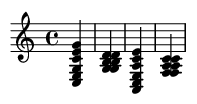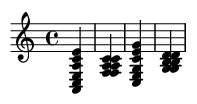What is the I-V-vi-IV Progression?
The I-V-vi-IV progression (one-five-six-four) is arguably the most influential chord sequence in the last 50 years of popular music. From rock anthems to pop ballads, this four-chord pattern has provided the harmonic foundation for countless hits, earning it nicknames like "the pop-punk progression" and "the sensitive female chord progression." Its power lies in a perfect blend of stability, tension, and emotional storytelling.
Harmonic Structure and Function
Using Roman numerals, we can analyze the role each chord plays within a major key. Each chord serves a distinct purpose in creating a satisfying emotional arc:
- I (Tonic): The "home base." This chord provides a sense of stability, rest, and resolution. The progression starts and often ends here.
- V (Dominant): The "cliffhanger." This chord creates strong tension and a powerful urge to resolve back to the tonic (I).
- vi (Submediant): The "relative minor" or "plot twist." Following the tense V chord, moving to vi instead of I is a deceptive cadence. It introduces a touch of melancholy or introspection, adding emotional depth.
- IV (Subdominant): The "setup." This chord has a pre-dominant function, gently leading the ear away from the minor feel of the vi chord and preparing the return to the tonic (I), creating a hopeful, circular feeling.
The Progression in Action: Key of C Major
In the key of C Major, the diatonic chords for the I-V-vi-IV progression are C Major, G Major, A minor, and F Major. Here is how they sound and are written on a musical staff.

Why It Works So Well
This progression's magic lies in its seamless blend of theoretical principles:
- The Deceptive Cadence (V → vi) : The listener's ear expects the tense V chord to resolve to the stable I chord. By moving to the relative minor (vi) instead, the progression creates a moment of surprise and emotional depth, pulling the listener in.
- Smooth Voice Leading: The notes in these chords are often very close to each other. For example, C Major (C-E-G) and A minor (A-C-E) share two common tones (C and E). This creates a fluid, connected sound that is pleasing to the ear.
- The Plagal "Amen" Cadence (IV → I): As the progression loops, the move from IV back to I feels like a gentle, satisfying resolution, known as a plagal cadence. This gives the sequence its endlessly repeatable, circular quality.
- A Complete Narrative: The progression tells a mini-story: Start at home (I), build tension (V), face a challenge or a moment of reflection (vi), and find a hopeful path back (IV), returning home (I).
Famous Songs Using This Progression
The list is nearly endless, but here are a few iconic examples spanning different genres and eras:
- "Let It Be" - The Beatles (Verse)
- "Don't Stop Believin'" - Journey (Verse)
- "With or Without You" - U2
- "Someone Like You" - Adele
- "Complicated" - Avril Lavigne
- "I'm Yours" - Jason Mraz
- "Africa" - Toto (Chorus)
The "Axis of Awesome" Variation: vi-IV-I-V
A hugely popular variation starts the sequence on the vi chord, creating the vi-IV-I-V progression. This is sometimes called the "Axis Progression" thanks to the comedy group The Axis of Awesome, who famously used it to play dozens of pop songs. Starting on the minor chord gives the progression a more melancholic or serious feel from the outset.
In C Major, this progression is Am - F - C - G.
Examples include "Zombie" by The Cranberries, "Apologize" by OneRepublic, and "Save Tonight" by Eagle-Eye Cherry.

How to Play and Customize the Progression
The beauty of I-V-vi-IV is its flexibility. You can make it your own by changing the texture, rhythm, and harmonic color.
- Rhythm: Instead of one chord per measure, try splitting a measure between two chords (e.g., I for two beats, V for two beats) . This changes the pace and feel entirely.
- Instrumentation: On guitar, use open chords for a folksy feel, barre chords for easy key changes, or power chords (root and fifth only) for a driving rock sound. On piano, use root position triads for strength or inversions for smoother bass movement.
- Arpeggiation: Break the chords into individual notes. This technique, called arpeggiation, adds elegance and motion, perfect for intros or verses.
Here's a simple arpeggiated pattern for the I-V-vi-IV progression in C Major:

Advanced Songwriting Tips
Ready to go beyond the basics? Try these techniques to make the progression feel fresh and unique:
- Add Extensions: Instead of simple triads, use 7th chords (e.g., Cmaj7 - G7 - Am7 - Fmaj7) or suspended chords (like Gsus4 before G) to add harmonic richness and complexity.
- Use Inversions: Change the bass note of a chord to something other than the root. For example, playing the V chord with its third in the bass (G/B in the key of C) creates a smooth, walking bass line (C → B → A).
- Break the Pattern: A great song knows when to deviate. After repeating the I-V-vi-IV progression for a verse, surprise the listener by moving to a different chord for the pre-chorus or bridge. This makes the return to the main progression even more satisfying.
Conclusion: A Timeless Tool for Songwriters
Some critics argue that the I-V-vi-IV progression is overused, a sign of creative laziness. But its continued dominance proves otherwise. It's not a formula for a hit, but a foundational harmonic structure—like a primary color for a painter. The true artistry comes from what you build on top of it: a compelling melody, an infectious rhythm, and a heartfelt story. By understanding how it works and how to customize it, you can unlock one of the most powerful and reliable tools in the modern songwriter's toolkit.
